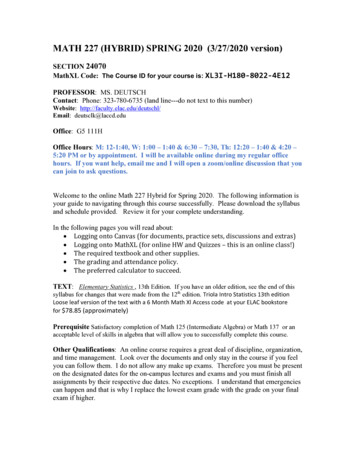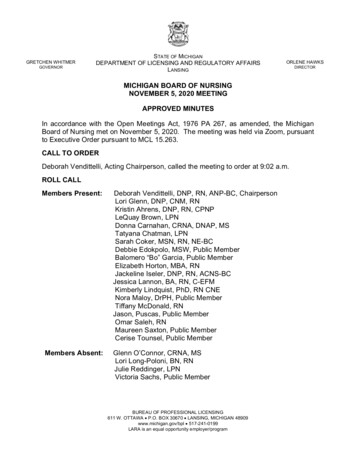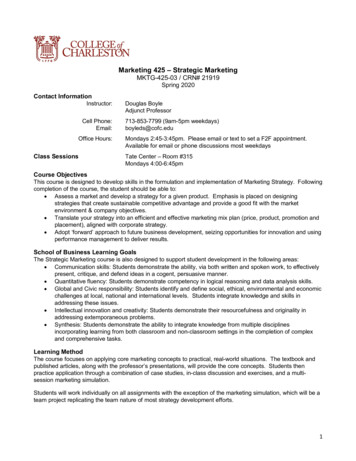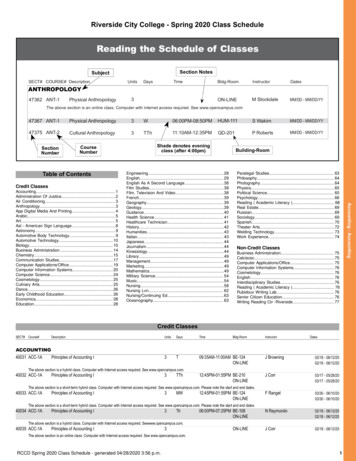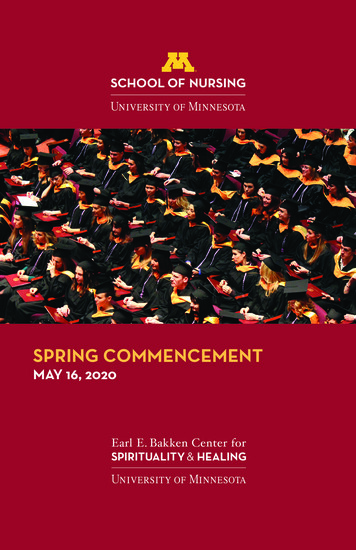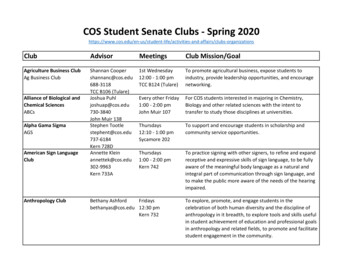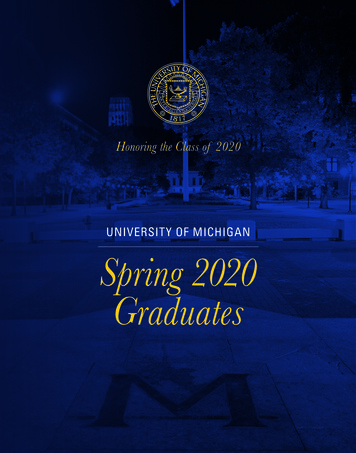
Transcription
Honoring the Class of 2020UNIVERSITY OF MICHIGANSpring 2020Graduates
Honoring theClass of 2020
S P R I N G G R A D U AT I O NUNIVERSITY OF MICHIGAN2020This book includes a list of the candidates for degrees to be granted upon completion of formal requirements. Candidatesfor graduate degrees are recommended jointly by the Executive Board of the Horace H. Rackham School of GraduateStudies and the faculty of the school or college awarding the degree. Following the School of Graduate Studies, schoolsare listed in order of their founding. Candidates within those schools are listed by degree then by specialization, ifapplicable.Horace H. Rackham School of Graduate Studies. 13College of Literature, Science, and the Arts. 23Medical School. 44Law School. 46School of Dentistry. 48College of Pharmacy. 49College of Engineering. 50A. Alfred Taubman College of Architecture and Urban Planning. 62School of Education. 63Stephen M. Ross School of Business. 64School for Environment and Sustainability. 73School of Music, Theatre & Dance. 74School of Nursing. 78School of Public Health. 79School of Social Work. 82University of Michigan-Flint. 83University of Michigan-Dearborn. 91School of Information. 100Penny W. Stamps School of Art & Design. 102School of Kinesiology. 104Gerald R. Ford School of Public Policy. 106This book presents as complete and accurate a record of candidates for degrees as is possible as of thepublication date.
2
LETTER FROM THE PRESIDENTDear Graduates,Class of 2020, you did it!On behalf of the Board of Regents and everyone at U-M, congratulations!Your final semester was one of unexpected difficulty, as you were forced to cross the finish line tograduation during a global pandemic. You persevered and succeeded nonetheless.I look forward to congratulating you in person when we convene for a Class of 2020 commencementceremony that we can safely host on campus.The COVID-19 pandemic has upended life throughout the United States and all around the world. But ithas also revealed once again the importance of research universities and the need for educated, creativeand talented people to rise to confront a challenge.This includes all of you.We have all seen the effects of the pandemic as they relate to medicine, public health, business, publicpolicy and education. At the same time, other disciplines have engaged deeply and importantly, whetherit is using technology to bring the arts to people while they shelter in their homes, or through examiningthe disparities among people that are being exacerbated by this virus.As a society, we need talented individuals in all disciplines to challenge the uncertain future that thepandemic has thrust upon us.I am ever so grateful that you, the University of Michigan Class of 2020, will rise to meet it.Go Discover.Go Achieve.Go Serve.And Go Blue!Sincerely,Mark S. SchlisselPresident3
REGENTS OF THE UNIVERSITYJordan B. AckerHuntington WoodsMichael J. BehmGrand BlancMark J. BernsteinAnn ArborPaul W. BrownAnn ArborShauna Ryder DiggsGrosse PointeDenise IlitchBingham FarmsRon WeiserAnn ArborKatherine E. WhiteAnn ArborMark S. Schlisselex officioEXECUTIVE OFFICERS4Mark S. SchlisselPresidentSusan M. CollinsInterim Provost and Executive Vice Presidentfor Academic AffairsThomas A. BairdVice President for DevelopmentSally J. ChurchillVice President and Secretary of the UniversityRebecca CunninghamVice President for ResearchKevin P. HegartyExecutive Vice President and Chief Financial OfficerTimothy G. LynchVice President and General CounselKallie Bila MichelsVice President for CommunicationsRavi PendseVice President for Information Technologyand Chief Information OfficerMarschall S. RungeExecutive Vice President for Medical AffairsSimone Himbeault TaylorInterim Vice President for Student LifeCynthia H. WilbanksVice President for Government RelationsDebasish DuttaChancellorUniversity of Michigan-FlintDomenico GrassoChancellorUniversity of Michigan-Dearborn
DEANSMichael S. BarrJoan and Sanford Weill Dean of Public Policy,Gerald R. Ford School of Public PolicyF. DuBois BowmanDean, School of Public HealthAnne CurzanDean, College of Literature, Science, and the ArtsJames T. DaltonDean, College of PharmacyScott DeRueEdward J. Frey Dean of Business, Stephen M. Ross School of BusinessThomas A. FinholtDean, School of InformationAlec D. GallimoreRobert J. Vlasic Dean of Engineering, College of EngineeringDavid A. GierDean, School of Music, Theatre & DanceJames L. HiltonUniversity Librarian and Dean of University LibrariesPatricia D. HurnDean, School of NursingJonathan MasseyDean, A. Alfred Taubman College of Architecture and Urban PlanningLaurie K. McCauleyDean, School of DentistryElizabeth Birr MojeDean, School of EducationGunalan NadarajanDean, Penny W. Stamps School of Art & DesignJonathan T. OverpeckSamuel A. Graham Dean, School for Environment and SustainabilityLori Ploutz-SnyderDean, School of KinesiologyMarschall S. RungeDean, Medical SchoolMichael J. SolomonDean, Horace H. Rackham School of Graduate Studiesand Vice Provost for Academic Affairs–Graduate StudiesLynn VidekaDean, School of Social WorkMark D. WestDean, Law School5
6
SCHOOLS AND COLLEGES OF THE UNIVERSITYIn order of year of founding.College of Literature,Science, and the ArtsThe College of Literature, Science, and the Arts, founded in 1841, was the firstduly constituted college of the University of Michigan. Today, with morethan 15,000 undergraduate and 2,000 graduate students, LSA is the largestof the University’s schools and colleges, and it is still the heart of the campus.Distinguished in the humanities since its earliest years, the college becamepreeminent in the natural sciences during the early 20th century and wenton to become a world leader in social science research. The college has alwaysbeen dedicated to providing a richly diverse liberal arts education that preparesstudents to lead fulfilling lives as responsible citizens within a wide range ofprofessional careers.Medical SchoolSince opening its doors in 1850, the Medical School has been a leader inmedical education, patient care, and biomedical research. In addition to itsprofessional doctor of medicine program, the Medical School offers master’sand doctoral degrees in the basic medical sciences. The school established thenation’s first university-owned and -operated teaching hospital and created thefirst departments of pharmacology and human genetics in the United States. Italso played an important role in the development of the electrocardiogram andin the development of iodized salt as a goiter preventive. The Medical Schoolwas among the first major American medical schools to graduate women andAfrican Americans; today there are more practicing M.D.s from the Universityof Michigan than from any other medical school in the United States.Law SchoolFounded in 1859, the Law School awarded its first bachelor of laws degreesin 1860. In 1870, the school became the second in the nation to confer a lawdegree on an African American candidate and the first major law school to admita woman. In 1871, one of the school’s graduates became the first woman with alaw degree to be admitted to the bar. A national law school from its earliest years,the school’s graduates work in every state of the union and in more than 73countries, in business, as practitioners and professors, as legislators and membersof Congress, and as distinguished civil servants and members of the judiciary.School of DentistryEstablished in 1875, the School of Dentistry first granted the professionaldegree, doctor of dental surgery, the following year. A national leader in thetraining of professional dentists and long active in oral and craniofacial research,the school offers the doctor of dental surgery, master’s degrees, and graduateclinical programs in several dental specialties and general dentistry. A doctoraldegree is offered in oral health sciences and in an interdepartmental programin biomaterials. The School of Dentistry also offers baccalaureate and master’sprograms in dental hygiene.College of PharmacyEstablished as a department in 1868, Pharmacy became a college in 1876, thefirst in any university in the United States. Today, the college has an averageannual enrollment of 260 doctor of pharmacy and 70 graduate students, and isconsistently ranked among the top pharmacy schools in the nation. The collegeoffers the doctor of pharmacy degree; baccalaureate programs in medicinalchemistry and pharmaceutical sciences; and doctor of philosophy programsin medicinal chemistry, pharmaceutical sciences, and social and administrativesciences. Major areas of research include the biological, chemical, clinical,genomic, economic, and social aspects of drugs and therapeutic agents.7
8College of EngineeringInstruction began with a class in civil engineering in 1854. Historically, the Collegeof Engineering has been a leader in establishing departments in emerging fields,including metallurgical engineering, naval architecture and marine engineering,electrical engineering, chemical engineering, aeronautical engineering, nuclearengineering, and computer engineering. Today, the college and its 60,000 alumniprovide leadership in various technologies, health care, business, and the sciences,improving the quality of people’s lives around the world.Horace H. RackhamSchool of GraduateStudiesThe Horace H. Rackham School of Graduate Studies oversees and coordinatesgraduate education, bringing together graduate students and faculty from acrossthe institution to experience and take full advantage of the University as ascholarly community. The University awarded its first master of arts degree in1849, first master of science degree in 1859, and first doctor of philosophy degreein 1876. Organized as a department in 1892, the School of Graduate Studiesbecame an autonomous unit in 1913. In 1935, a generous gift from HoraceH. and Mary A. Rackham included the site and construction of the RackhamBuilding for graduate studies and a substantial endowment for carrying ongraduate work and research.A. Alfred TaubmanCollege of Architectureand Urban PlanningMichigan offered its first courses in architecture in 1876. The program becamea department in 1913, and by 1931, the College of Architecture was establishedas a separate entity. During the 1940s, the college was one of the few schools inthe country to consider research a necessary part of architectural education, andin 1946 it became the first to introduce a graduate program in urban planning.The college offers master of architecture, master of urban planning, and masterof urban design degrees; bachelor of science and master of science degrees inarchitecture; and doctoral programs in architecture and in urban and regionalplanning. In 1999, the college was named in honor of A. Alfred Taubman,founder and chairman of The Taubman Company, Inc., and a longtime friend,supporter, and adviser to the college.School of EducationThe School of Education was founded in 1921, 42 years after the Universityestablished the first chair in any United States collegiate institution devoted tothe “science and art of teaching.” The school prepares students for professionalcareers in teaching and administration, and offers advanced training forresearchers and practitioners at all levels of education. Teacher diplomas werefirst offered in 1874; the first master’s degree in education was conferred in1891, the first Ph.D. in 1902, and the first Ed.D. in 1938.Stephen M. RossSchool of BusinessBuilding on faculty and course offerings that began in the latter part of the 19thcentury, the school was formally established in 1924. Today, at all levels ofinstruction—bachelor’s, master’s, doctoral, and executive education—itsprograms rank in the top five among American institutions. Each year nearly1,000 new School of Business graduates enter careers as business professionalsand teacher-scholars, joining the approximately 37,000 who already servein leadership positions in business, government, and academic institutionsthroughout the world.School for Environmentand SustainabilityThe clear-cutting of Michigan’s densely forested wilderness was well under waywhen the University of Michigan began offering courses in forestry in 1881—thefirst university in the United States to do so. The year 1903 saw the creationof a Department of Forestry, forerunner of today’s School for Environmentand Sustainability (SEAS). The school’s students and faculty organized thefamous 1970 Teach-In on the Environment (the prototype of Earth Day), andincubated the scholarly disciplines of Environmental Justice, EnvironmentalEducation, and Environmental Informatics. From its inception as a forestryschool to the interdisciplinary institution it is today, SEAS has always preparedleaders to understand and solve the major environmental challenges of the era.
School of Music,Theatre & DanceConsistently ranked among the top performing arts schools in the nation, andone of the oldest, the School of Music, Theatre & Dance is committed to creatingan environment of educational and artistic excellence, nurturing creativity,academic integrity, and professionalism in its students and faculty. With degreesoffered at the bachelor’s, master’s, and doctoral levels, the School is deeplyengaged in the creation, practice, scholarship, and pedagogy of music, theatre, anddance. It fosters a spirit of social responsibility and principled entrepreneurship,and serves the community and State of Michigan through public performances,cultural resources, arts education, and outreach programs.School of NursingThe University of Michigan School of Nursing (UMSN) is an internationalleader in the advancement of nursing knowledge and strategies to improvehealth care. In addition to the four-year BSN program and the second career innursing program, UMSN has a robust offering of graduate programs. Studentsare prepared to be leaders in advanced clinical practice through our M.S.N. andpost-baccalaureate Doctorate of Nursing Practice (DNP) programs. Studentscan also lead and effect change through the M.S.N. or post-masters DNPprograms in systems, populations, and leadership. UMSN’s prestigious Ph.D.and postdoctoral programs prepare nurse scientists to develop the knowledgenecessary to support and advance nursing practice.School of Public HealthFounded in 1941 and ranked among the country’s top public health schools,the University of Michigan School of Public Health educates more than 1,000graduate and undergraduate students each year. With over 170 faculty andresearchers across six departments and numerous collaborative centers andinstitutes, the school brings interdisciplinary, innovative solutions to complexhealth challenges, including chronic and infectious diseases, obesity and foodinsecurity, health care quality and cost, climate change and environmentalfactors, and socioeconomic inequalities and their impact on health. Compassion,innovation, and inclusion drive the faculty, staff, students, and 15,000 alumniof Michigan Public Health to pursue positive change and lasting impact on thehealth of the world.School of Social WorkThe program in social work began in 1921, and was granted the status of aschool in 1951. Faculty maintain high research productivity while teaching aninnovative curriculum. At the master’s level, the school prepares professionalpractitioners for work with individuals, children and their families, the aged,organizations, and communities. Students may focus their studies in the fieldsof substance abuse, mental health, education, child welfare, program evaluation,and public policy. The joint doctoral program in social work and social scienceis one of a kind and prepares students for academic and research careers.Graduates of both programs are found in leadership positions around the world.The School of Social Work consistently ranks as one of the best in the nation.School of InformationA formal program began in 1926, when the Department of Library Science wascreated in the College of Literature, Science, and the Arts. In 1948, offeringsbecame entirely graduate and a doctoral program was inaugurated. Establishmentof an independent school, committed to the interdisciplinary study of informationand library principles, came in 1969. In response to the rapid change brought onby present technology, the school broadened significantly further in the 1990s.It now pursues a highly interdisciplinary approach to educate professionals whowill serve as leaders in the information age. Recognizing this broader mission,the school was renamed the School of Information in 1996.9
10Penny W. StampsSchool of Art & DesignThe Penny W. Stamps School of Art & Design traces its history at the Universityto visual arts education in the late 19th century, awarding its first degree in1960, and becoming a University of Michigan school in 1974. In 2002, theschool launched a unique curriculum that prompted the National Associationof Schools of Art and Design to report, “The School of Art & Design and theUniversity of Michigan have created an opportunity to lead the academicconversation in art and design in this country.” The school prepares graduatesfor a broad range of creative professions thro
Stephen M. Ross Building on faculty and course offerings that began in the latter part of the 19th School of Business century, the school was formally established in 1924. Today, at all levels of instruction—bachelor’s, master’s, doctoral, and executive education—its programs rank in the top five among American institutions. Each year .
